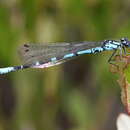Conservation Status
provided by University of Alberta Museums
Not currently a concern. Subarctic bluets are not commonly found and their biology is not well documented. It remains the least known Eurasian bluet (Walker 1953, Acorn 2004).
- license
- cc-by-nc
- copyright
- University of Alberta Museums
Cyclicity
provided by University of Alberta Museums
Adults fly late May to late July depending on latitude.
- license
- cc-by-nc
- copyright
- University of Alberta Museums
Distribution
provided by University of Alberta Museums
Most northerly range of the Eurasian bluets with records in Alaska, Yukon, Northwest Territories, throughout most of Canada and east to Newfoundland. Found in some northerly states towards the east and much of New England.
- license
- cc-by-nc
- copyright
- University of Alberta Museums
General Description
provided by University of Alberta Museums
"The subarctic bluet is similar in size and proportions to the taiga bluet (C. resolutum) but has different colour patterns and markings (Walker 1953). Males have a black mark on the underside of the thorax in the shape of a Y while the taiga bluet has no markings (Westfall and May 1996). On each side of the top of the thorax are wide, broken blue strips (appear to be on their shoulders) that are wider than the black strips below (Walker 1953, Acorn 2004). Female subarctic bluets also have black markings on the underside of the thorax (Westfall and May 1996) Abdominal segments 3 to 7 have dark streaks on the underside and blue or greenish rings, segments 8 and 9 have blue or greenish areas on the dorsal surface (Walker 1953, Acorn 2004). Subarctic bluets are small damselflies, rarely exceeding 3 cm in length.
Larvae of the subarctic bluet are difficult to distinguish from the other Eurasian bluets (C. angulatum and C. resolutum) or even American bluets (genus Enallagma) or forktails (genus Ischnura). The subarctic bluet has no obvious characters that allows for identification in the field; two published keys use very finely detailed characters (Baker and Clifford 1980, Canning and Canning 1980). Coenagrion larvae are of average stature with the posterior margin of the head rounded and eyes not very prominent (Walker 1953)."
- license
- cc-by-nc
- copyright
- University of Alberta Museums
Habitat
provided by University of Alberta Museums
Open marshes and bogs with cool water and preferably abundant aquatic mosses.
- license
- cc-by-nc
- copyright
- University of Alberta Museums
Life Cycle
provided by University of Alberta Museums
There is no specific life history information available for the subarctic bluet. However, they occur in the same range and have similar seasonality to the prairie and taiga bluets and therefore will likely have comparable life styles. Sawchyn and Gillott (1975) performed a detailed study on the biology of prairie taiga bluets in Saskatchewan. Females lay soft, creamy-white eggs during June and July in cuts made in living, aquatic plant tissue. Embryonic development takes 2 to 3 weeks. Larvae develop rapidly and near completion by October. They over-winter in one of the final three stages (instars) of development, frozen in the ice that forms in their shallow habitat. The larvae intentionally place themselves where they become embedded in the ice but do not freeze. The larvae remain dormant until April when the ice melts and then continues development. This adaptation likely does not occur throughout the subarctic bluets range. Larvae leave the water to become adults by mid-June. Newly emerged adults disperse from the larval habitat to feed and mature. Maturation requires about 1 week and mating occurs away from the water, oviposition occurs within 2 weeks of adult emergence. Oviposition occurs with the male still attached to the female. Eggs are may be deposited above or below the water surface on floating or emergent vegetation. Baker and Clifford (1981) report that taiga bluets can take two years to complete their life cycle; this is likely the case with prairie bluets.
- license
- cc-by-nc
- copyright
- University of Alberta Museums
Trophic Strategy
provided by University of Alberta Museums
Specific diet is unknown but likely similar to that of the taiga bluet. Adults feed on flies (e.g. midges) (Sawchyn and Gillott 1975). Larvae prey upon fly larvae, water fleas, other odonate larvae and assorted invertebrates (Baker and Clifford 1981).
- license
- cc-by-nc
- copyright
- University of Alberta Museums
Coenagrion interrogatum
provided by wikipedia EN
Coenagrion interrogatum, the Subarctic bluet, is a blue and black, pond damsel of the family Coenagrionidae. The species was first described by Edmond de Sélys Longchamps in 1876.
Distribution
According to the University of Alberta E.H. Strickland Entomological Museum:
Most northerly range of the Eurasian bluets with records in Alaska, Yukon, Northwest Territories, throughout most of Canada and east to Newfoundland. Found in some northerly states towards the east and much of New England.[1]
References

- license
- cc-by-sa-3.0
- copyright
- Wikipedia authors and editors
Coenagrion interrogatum: Brief Summary
provided by wikipedia EN
Coenagrion interrogatum, the Subarctic bluet, is a blue and black, pond damsel of the family Coenagrionidae. The species was first described by Edmond de Sélys Longchamps in 1876.
- license
- cc-by-sa-3.0
- copyright
- Wikipedia authors and editors

